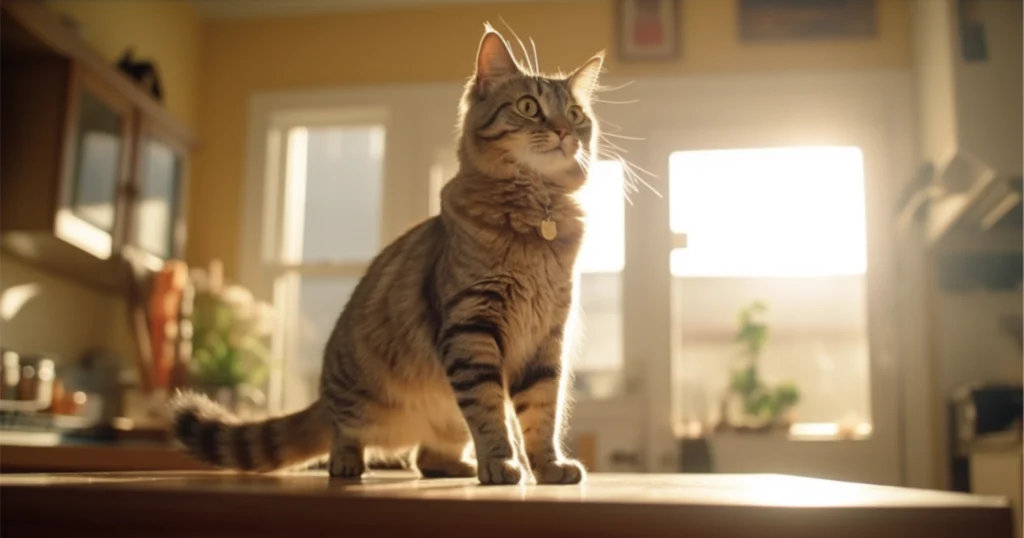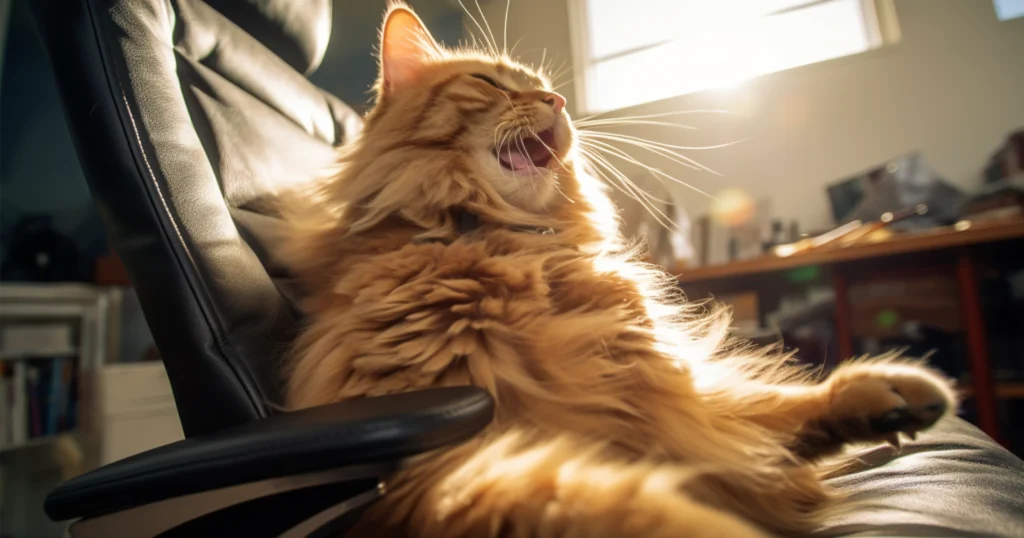Cats bring endless joy to our lives. Their quirky antics, fuzzy cuddles, and purr-filled greetings melt our hearts. Yet, the home, our sanctuary, can be a perilous playground for our feline friends if not adequately cat-proofed. Cat-proofing isn’t just about safeguarding our belongings from feline curiosity but is fundamentally a matter of protecting our beloved pets from potential hazards.
In this article, we’ll delve into “how to cat proof your house”, to provide a secure environment that both you and your feline companion can enjoy. We’ll explore why understanding your cat’s behavior is crucial, how to secure furniture, manage cords, and even share tips on safely storing household chemicals.
So, let’s kickstart this journey of creating a safer habitat for our whiskered friends, without compromising their inherent need for exploration and play.
Understanding Your Cat’s Behavior

Understanding your cat’s behavior is key to successfully cat-proofing your home. Cats are naturally curious creatures. This curiosity, although endearing, can lead them to stumble into hazardous situations. Their instinctual behaviors, like climbing, scratching, and exploring can often spell disaster in a house not adequately cat-proofed.
Cats, much like their larger feline counterparts, are born climbers. They have a penchant for high places, whether it’s the top of a bookshelf or your kitchen cabinets. This propensity for heights, however, can lead to tumbles, especially if the furniture isn’t stable enough to hold their weight.
Next up, we have their notorious curiosity. Ever heard of the phrase “curiosity killed the cat”? That’s because cats love to investigate every nook and cranny, which can expose them to dangers like choking on small objects, getting tangled in cords, or accidentally ingesting harmful substances.
Lastly, scratching is an innate behavior in cats. It’s their way of marking territory, stretching their muscles, and maintaining their claws. But this can result in damaged furniture if you don’t provide suitable alternatives like scratching posts.
How to Secure Your Furniture

Securing your furniture can prevent unexpected mishaps and allow your cat to enjoy their climbing escapades safely.
Start by anchoring tall, lightweight furniture like bookshelves and dressers to the wall using furniture straps or L-brackets. These handy tools can withstand the weight of your cat, keeping them safe from toppling furniture.
Consider using non-slip pads or rubber stoppers under smaller items to prevent them from being nudged off surfaces. Also, keep items like vases or picture frames out of your cat’s reach.
But remember, stopping them from climbing altogether isn’t the goal. Provide them with appropriate climbing options. Invest in a sturdy cat tree or cat shelves. They not only serve as a safe climbing outlet but also double as a scratching post, saving your furniture from cat scratch fever!
How to Manage Cords and Small Items

Cats are fascinated by dangling objects and small items, but these can pose serious risks, like choking and electrocution. Proper management is essential to keep your cat safe.
Electric cords and charger cables can be appealing playthings to a cat. To keep these out of their reach, use cord protectors or cable sleeves. You can also bundle cords together and secure them out of sight using cord boxes or zip ties.
As for small objects like hair ties, jewelry, or tiny toys, it’s crucial to keep these out of your cat’s paw-reach. Cats might mistake them for prey, leading to accidental ingestion. Store these items in closed containers or high shelves where your cat can’t reach them.
How to Secure Windows, Doors, and Appliances

Secure windows, doors, and appliances play a crucial role in creating a cat-safe home. Let’s explore some steps to keep our feline companions secure.
Cats are nimble creatures and may squeeze through small window or door gaps, risking falls or escapes. Install window guards or sturdy screens to ensure their safety. These allow fresh air and natural light in while keeping your cat secure. Similarly, door stoppers can prevent slamming doors, safeguarding your cat’s paws.
As for appliances, your cat’s curiosity may lead them to explore spaces like the washing machine, dryer, or even the refrigerator. Always check these appliances before use, keeping their doors closed when not in use.
Lastly, secure potentially hazardous appliances like irons, heaters, or cooking utensils. A simple barrier or using these appliances in a separate room where your cat doesn’t have access can prevent burns or other injuries.
How to Safely Store Household Chemicals

Cats are susceptible to many household chemicals like cleaning agents, pesticides, and even some human foods. These can cause anything from mild discomfort to serious health issues.
Ensure chemicals are stored securely. Use high shelves or lockable cabinets, away from your cat’s reach and sight. Never leave open containers unattended.
Also, be mindful when using these substances. Cats can easily step in a spilled chemical and later ingest it during grooming.
Your vigilance in safely storing household chemicals is a significant step in cat-proofing your house. It’s not just about cleanliness; it’s about safeguarding your furry friend’s health and wellbeing.
How to Avoid Toxic Plants and Other Hazards

Household plants can add life to your home, but some are toxic to cats. These include lilies, azaleas, daffodils, and English ivy, to name a few. If ingested, they can cause symptoms like vomiting, drooling, or worse, organ failure. Consider replacing these with cat-friendly options like spider plants, Boston ferns, or catnip.
Apart from plants, other hazards like open flames, hot stovetops, and even lit candles can pose a risk to your agile cat. Electric and induction stoves are safer alternatives to gas stoves. Consider flameless candles to create ambiance without the risk.
Small objects like coins, buttons, or plastic caps can also be a choking hazard for your curious cat. Regularly check your home for such items and ensure they’re out of reach. Also, keep garbage cans covered to prevent your feline friend from rummaging and accidentally ingesting something harmful.
Remember, avoiding these hazards doesn’t mean stifling your cat’s curiosity. It’s about steering it in a safe direction. With these precautions, you can let your cat indulge their inquisitive nature while maintaining peace of mind.
Investing in Cat-Proofing Products

Investing in cat-proofing products can ease the process of creating a safe environment for your cat. Various options are available, each tailored to specific needs.
For instance, furniture straps and wall anchors are great for securing unstable furniture, while cord protectors can safeguard your cat from electric wires. Non-toxic, bitter-tasting sprays can deter your cat from chewing on dangerous objects.
Then there are cat trees and scratching posts to satisfy your cat’s need to climb and scratch safely. You could even invest in cat window perches for their love of heights.
Remember, the right time to use these products is now. Cat-proofing is a proactive measure, not a reactive one. Start with the areas your cat frequents the most and gradually expand to other parts of your house.
It’s important to keep in mind that these products are aids, not substitutes, for supervision and training. The goal is to create a home where your cat can safely engage in their natural behaviors. With these products, you’re one step closer to achieving this!
How to Protect Your Furniture

Cats scratch by nature—it’s a way they mark territory and keep their claws healthy. But it’s a different story when your beloved sofa becomes the target. Fortunately, there are ways to protect your furniture without curbing your cat’s instincts.
Scratching posts are a lifesaver. Choose one with sturdy construction and a texture your cat loves. Place it near the furniture your cat usually targets. Infusing it with catnip can make it more enticing.
For added protection, use furniture protectors. These are sheets of plastic or sticky tape that can deter your cat from scratching.
If your cat still scratches the furniture, gently redirect them to the scratching post. Consistency is key here. It’s also important to keep their claws trimmed to minimize damage.
Conclusion
Learning how to cat-proof your house boils down to understanding your cat’s behavior, securing furniture, managing cords, securing doors, windows, and appliances, safely storing household chemicals, avoiding toxic plants, and investing in cat-proofing products. And of course, let’s not forget the importance of protecting our beloved furniture.
It may seem like a lot, but each step is a testament to the love and care you have for your feline companion. Remember, it’s not about restricting your cat, but about making their natural behavior safer. So let’s take that leap. After all, a secure home isn’t just for us; it’s for our whiskered friends too. Your cat will thank you—probably with a contented purr—once your home becomes their safe haven. Let’s make it happen!


